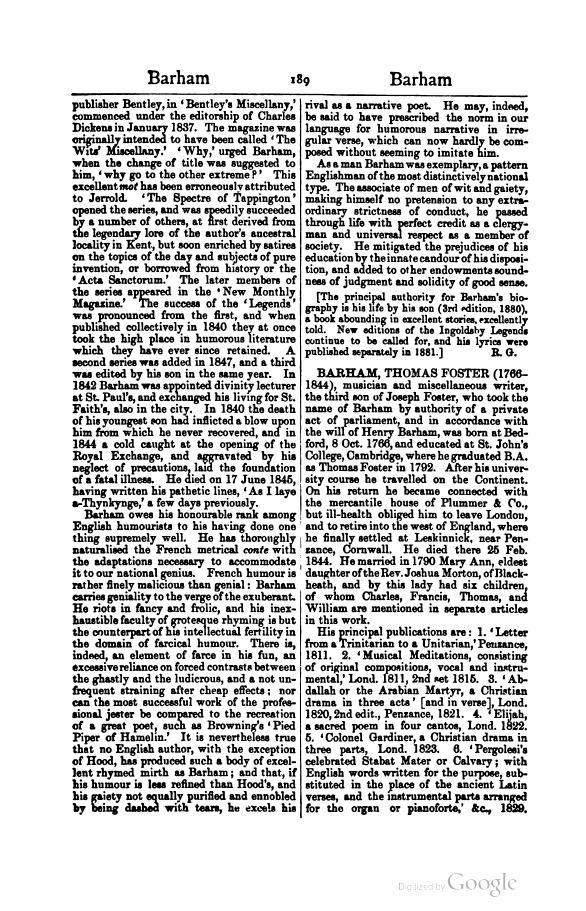publisher Bentley, in ‘Bentley's Miscellany,’ commenced under the editorship of Charles Dickens in January 1837. The magazine was originally intended to have been called ‘The Wits' Miscellany.’ ‘Why,’ urged Barham, when the change of title was suggested to him, ‘why go to the other extreme?’ This excellent mot has been erroneously attributed to Jerrold. ‘The Spectre of Tappington’ opened the series, and was speedily succeeded by a number of others, at first derived from the legendary lore of the author's ancestral locality in Kent, but soon enriched by satires on the topics of the day and subjects of pure invention, or borrowed from history or the ‘Acta Sanctorum.’ The later members of the series appeared in the ‘New Monthly Magazine.’ The success of the ‘Legends’ was pronounced from the first, and when published collectively in 1840 they at once took the high place in humorous literature which they have ever since retained. A second series was added in 1847, and a third was edited by his son in the same year. In 1842 Barham was appointed divinity lecturer at St. Paul's, and exchanged his living for St. Faith's, also in the city. In 1840 the death of his youngest son had inflicted a blow upon him from which he never recovered, and in 1844 a cold caught at the opening of the Royal Exchange, and aggravated by his neglect of precautions, laid the foundation of a fatal illness. He died on 17 June 1845, having written his pathetic lines, ‘As I laye a-Thynkynge,’ a few days previously.
Barham owes his honourable rank among English humourists to his having done one thing supremely well. He has thoroughly naturalised the French metrical conte with the adaptations necessary to accommodate it to our national genius. French humour is rather finely malicious than genial: Barham carries geniality to the verge of the exuberant. He riots in fancy and frolic, and his inexhaustible faculty of grotesque rhyming is but the counterpart of his intellectual fertility in the domain of farcical humour. There is, indeed, an element of farce in his fun, an excessive reliance on forced contrasts between the ghastly and the ludicrous, and a not unfrequent straining after cheap effects; nor can the most successful work of the professional jester be compared to the recreation of a great poet, such as Browning's ‘Pied Piper of Hamelin.’ It is nevertheless true that no English author, with the exception of Hood, has produced such a body of excellent rhymed mirth as Barham; and that, if his humour is less refined than Hood's, and his gaiety not equally purified and ennobled by being dashed with tears, he excels his rival as a narrative poet. He may, indeed, be said to have prescribed the norm in our language for humorous narrative in irregular verse, which can now hardly be composed without seeming to imitate him.
As a man Barham was exemplary, a pattern Englishman of the most distinctively national type. The associate of men of wit and gaiety, making himself no pretension to any extraordinary strictness of conduct, he passed through life with perfect credit as a clergyman and universal respect as a member of society. He mitigated the prejudices of his education by the innate candour of his disposition, and added to other endowments soundness of judgment and solidity of good sense.
[The principal authority for Barham's biography is his life by his son (3rd edition, 1880), a book abounding in excellent stories, excellently told. New editions of the Ingoldsby Legends continue to be called for, and his lyrics were published separately in 1881.]
BARHAM, THOMAS FOSTER (1766–1844), musician and miscellaneous writer, the third son of Joseph Foster, who took the name of Barham by authority of a private act of parliament, and in accordance with the will of Henry Barham, was born at Bedford, 8 Oct. 1766, and educated at St. John's College, Cambridge, where he graduated B.A. as Thomas Foster in 1792. After his university course he travelled on the Continent. On his return he became connected with the mercantile house of Plummer & Co., but ill-health obliged him to leave London, and to retire into the west of England, where he finally settled at Leskinnick, near Penzance, Cornwall. He died there 25 Feb. 1844. He married in 1790 Mary Ann, eldest daughter of the Rev. Joshua Morton, of Blackheath, and by this lady had six children, of whom Charles, Francis, Thomas, and William are mentioned in separate articles in this work.
His principal publications are: 1. ‘Letter from a Trinitarian to a Unitarian,’ Penzance, 1811. 2. ‘Musical Meditations, consisting of original compositions, vocal and instrumental,’ Lond. 1811, 2nd set 1815. 3. ‘Abdallah or the Arabian Martyr, a Christian drama in three acts’ [and in verse], Lond. 1820, 2nd edit., Penzance, 1821. 4. ‘Elijah, a sacred poem in four cantos,’ Lond. 1822. 5. ‘Colonel Gardiner, a Christian drama in three parts,’ Lond. 1823. 6. ‘Pergolesi's celebrated Stabat Mater or Calvary; with English words written for the purpose, substituted in the place of the ancient Latin verses, and the instrumental parts arranged for the organ or pianoforte,’ &c., 1829.
